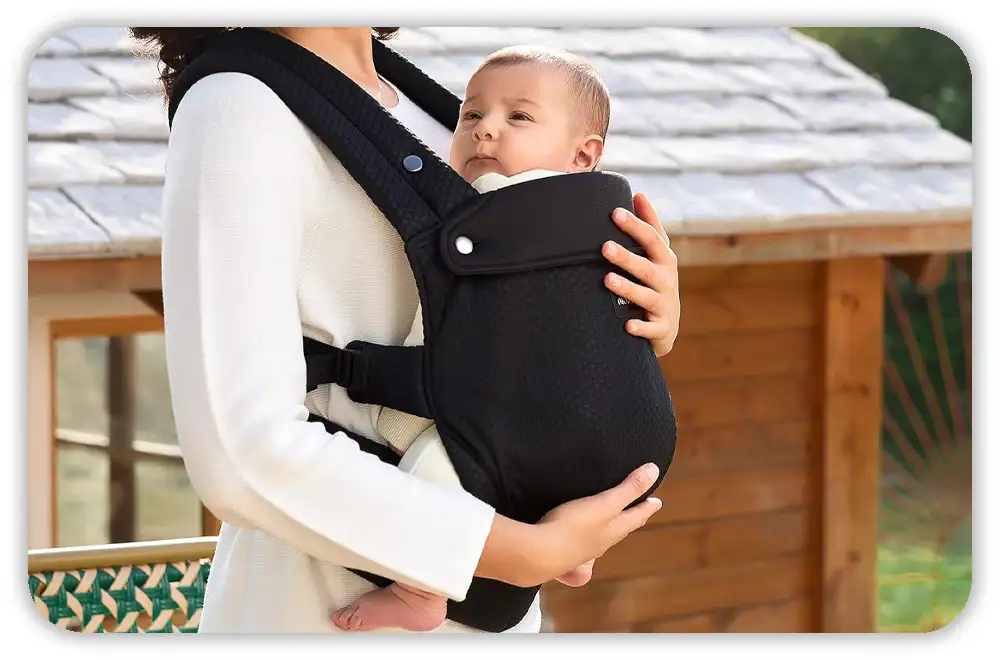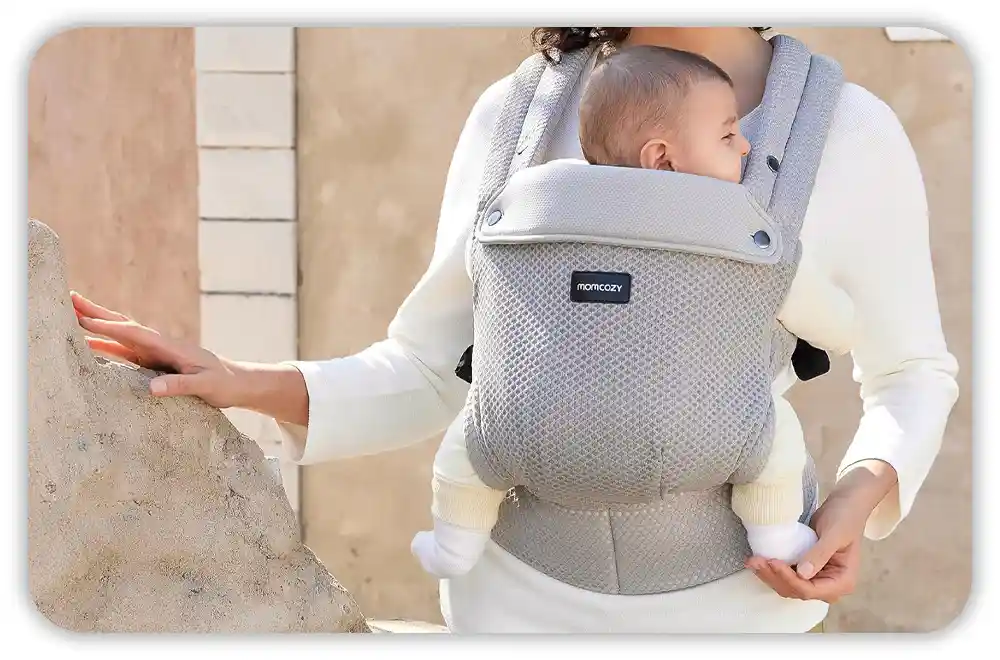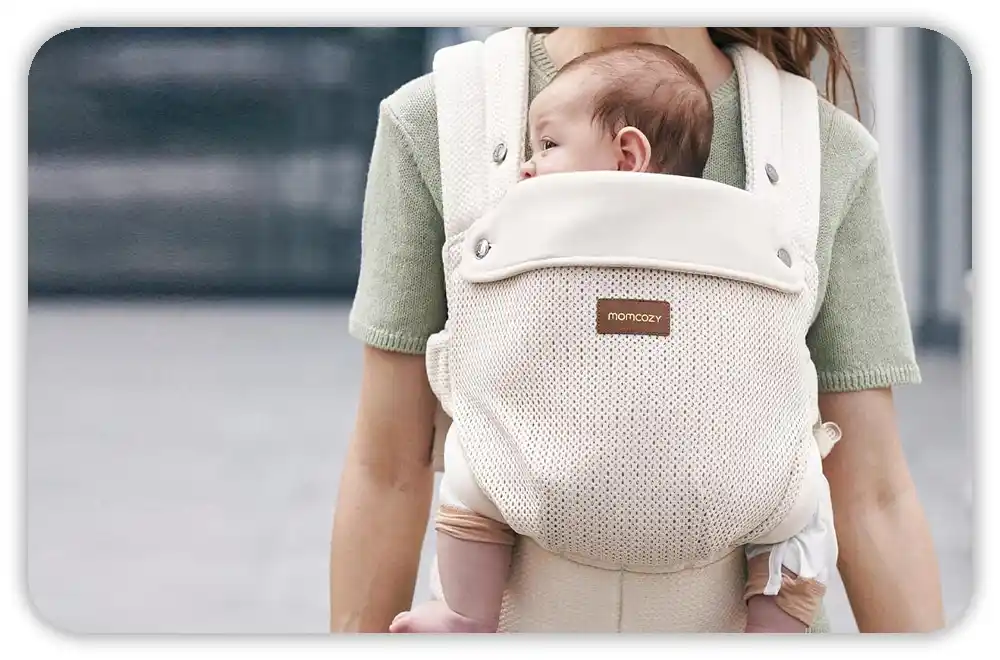Wondering if the Momcozy carrier is hip-healthy for your baby? Yes — many Momcozy carriers are safe for baby hips when used the right way. Experts and parents agree.
As a mom who’s tried a few carriers (with a fussy baby who hated bad hip support!), I know how much those tiny leg positions matter.
I checked the design, hip support, and what real parents had to say — so you can feel good about holding your baby close. Let’s break it all down — simply, mom to mom.
Table of Contents
What Does “Hip-Healthy” Really Mean?
So, what makes a baby carrier hip-healthy? It’s easier than it sounds — and super important if you carry your baby a lot (like I do on school runs, grocery trips, and even while cooking).
A hip-healthy carrier keeps your baby’s legs in a safe spot. Their knees should be bent and lifted, with thighs supported — kind of like an “M” shape. Their bottom should sit lower than their knees, not hang straight down. This “M-position” helps your baby’s hips grow the right way.
The Role of the International Hip Dysplasia Institute (IHDI)
The IHDI is a group of doctors who study baby hip growth. They test baby carriers and approve the ones that support safe leg and hip placement.
If a carrier is “IHDI-certified,” it means it’s been reviewed and found safe — especially in those first few key months.
How Can You Tell If a Carrier Is Hip-Healthy?
Here’s what I look for now (and wish I knew back then):
- Wide seat base: It should go from thigh to thigh, not just under the crotch.
- Knees higher than bottom: Their knees should sit above the hips, not below.
- Soft, stretchy fabric: Lets legs move and supports the spine.
- Adjustable fit: Helps you shift baby’s seat as they grow.
Meet the Momcozy Baby Carrier: Quick Overview
Before we go deep, here’s a quick peek at what makes the Momcozy carrier so loved by new parents.

Types of Momcozy Carriers
Momcozy makes a few styles, but these two are most popular:
- Momcozy Wrap Carrier – soft and stretchy. You tie it around your body. Great for newborn cuddles and skin-to-skin.
- Momcozy Ergonomic Carrier – has padded straps and a waist belt. Uses buckles for support and different wearing options.
Some parents also mention a hybrid type. It’s stretchy like a wrap but has clips, so it’s easier to put on.
Materials, Weight Limits & Mom-Approved Features
- Made of soft, breathable cotton (a win for hot days — especially here in the South!)
- Weight limit: usually from 7 to 44 pounds, based on the model
- Machine washable — a lifesaver on spit-up days
- Padded straps for comfy wear
- Some models let you carry baby in front or back
- Hands-free for chasing toddlers while holding baby
Who It’s For
Momcozy carriers are great for:
- Newborns and toddlers (depending on the model)
- Moms who want a budget-friendly pick (many cost under $60)
- First-time babywearers — the wrap feels cozy and easy to learn
I started with the wrap when my son was just weeks old. It felt like a soft hug — and I could finally eat lunch with two hands!
Is the Momcozy Carrier Hip Healthy?
Now, the big question — is Momcozy hip-healthy?
IHDI Certification Status
Right now, Momcozy carriers are not certified by the International Hip Dysplasia Institute (IHDI). But that doesn’t mean they’re bad. Many moms (me included) found they help with healthy hip placement when used right.
How It Supports the M-Position
Even without the IHDI label, Momcozy does well with hip support.
- Wrap style: You can shape the fabric into a deep seat, with knees higher than the bum.
- Ergonomic version: Has a wide seat that supports baby from knee to knee. That’s key for hip health.
Just check the seat fit — especially with tiny babies. If the fabric is too narrow, their legs may dangle. That’s not good for growing hips.
Fit and Adjustability
I’m 5’3″, and my husband is 6’1″ — and we both used the ergonomic carrier. The belt adjusted well, and the straps fit his broader shoulders too.
The wrap is even more flexible. Tie it tighter or looser, based on your size. I needed three tries to get it right — but now it’s easy.
My Mom Take: How My Baby’s Hips Sat in the Carrier
At first, I was nervous. I kept checking my son’s legs — were his knees high enough? Was his back curved?
Once I got him in right, I saw the “M” shape. His knees were up, thighs snug, bottom low. He looked comfy. And he slept while I cleaned the kitchen. Total win.
What Pediatricians and Experts Say
I also looked into what doctors say about babywearing and hips.

What the Medical Experts Say
The American Academy of Pediatrics says a baby’s hips are still forming in the first few months. That’s why leg support matters — especially for babies who stay in carriers a lot.
Babies with hip issues (like DDH) are more at risk if their legs hang. That’s why hip-friendly carriers aren’t just comfy — they’re important for health.
Trusted Sources on Babywearing Safety
The International Hip Dysplasia Institute suggests choosing carriers that:
- Keep hips and legs spread wide
- Support the thighs
- Keep knees bent
Pediatric therapists also say to avoid narrow, crotch-only styles — especially in the early months.
Even without IHDI tags, a carrier can be safe — if you use it the right way. It’s all about baby’s position.
What I Loved About Using the Momcozy Carrier
Now, here’s the fun stuff — what I actually liked.
Comfort (For Me and Baby)
The wrap felt like a cozy hoodie. It was snug, but not tight. The stretchy fabric hugged my baby without hurting my back.
The structured carrier gave more support. It worked great for errands and long walks. The padded straps were a game-changer during Target runs!
Hip and Leg Position (In Real Life)
Each time I used the carrier, I checked my baby’s legs. I tucked the fabric under his thighs, raised his knees, and made sure the seat was wide.
He looked like a tiny frog hugging my chest — that’s the perfect M-shape!
Everyday Convenience
This carrier let me:
- Cook while baby napped
- Shop with both hands free
- Walk without a stroller
- Rock him to sleep during the evening fuss
Honestly, it helped me feel like myself again — not just stuck on the couch.
Potential Concerns to Watch For
Let’s be real — even a great carrier like Momcozy can cause issues if used the wrong way. And yes, that can affect your baby’s hips.

Common Positioning Mistakes
I’ve made these before — no shame at all:
- Legs hanging straight down (they should be bent)
- Baby’s bum not fully supported (you want a deep “seat”)
- Carrier worn too low or too loose
Sometimes it looks okay, but a quick check can help.
When You Shouldn’t Use a Carrier
If your baby has hip dysplasia or hip issues, talk to your doctor first. Some babies need special care — and a carrier might make things worse if it’s not approved.
Also, stop and check if:
- Baby cries every time you wear them
- One leg sticks out more than the other
- Baby feels stiff or favors one side
Warning Signs to Watch For
- Knees are lower than the bum (not an “M” shape)
- Baby slouches or leans to one side
- Your back hurts — could be a fit issue
- One leg hangs lower than the other
A good carrier should feel right for both of you.
Tips for Using Any Baby Carrier Safely
Worried about using the carrier right? I’ve been there. These quick checks help me every time.
My Go-To Checklist:
- Knees are higher than the bum (like a frog)
- Legs spread wide — no dangling
- Spine forms a soft “C”
- Baby’s face is in view, close enough to kiss
- Carrier is snug, not loose or leaning
If all five check out, I’m good to go.
When to Start and Stop Using a Carrier
Most carriers (like Momcozy) are safe from 7 pounds and up.
I started using one at 2 weeks — once feeding was steady and baby was healthy.
I stopped around 35 pounds — when my son decided running was better than snuggling
My 2-Minute Hip Check
I do this every single time:
- Look: Are the knees up and out?
- Feel: Is the seat wide under the bum?
- Check: Is baby upright and not slumped?
- Adjust: Are the straps tight and comfy?
Sounds like a lot, but once it’s a habit, it’s fast.
Read More: How Long Are Infant Car Seats Good For?
Final Verdict: Is the Momcozy Carrier Hip Healthy?
So, is the Momcozy carrier hip-healthy?
Yes — if you use it right, it supports safe leg and hip growth.
Why It Works
Even without IHDI certification, it offers:
- A wide seat
- M-shape support
- Adjustable straps
- Real-world comfort (from real moms!)
When It’s a Good Fit
- For newborns and small babies
- If you watch baby’s leg position
- If you want comfort at a good price
When You Might Want Another Option
- If your baby has hip dysplasia
- If you want the IHDI label for peace of mind
- If baby still looks uncomfy after adjusting
FAQs: Is Momcozy carrier hip healthy
Is the Momcozy carrier hip healthy for babies?
Yes, the Momcozy carrier supports a baby’s hips in the “M” shape, which is healthy and safe for proper hip development.
Is the Momcozy carrier approved by pediatricians?
While not officially certified by doctors, its hip-healthy design aligns with guidelines from the International Hip Dysplasia Institute.
Can I use the Momcozy carrier for newborns with hip issues?
Yes, but always check with your pediatrician first. The wide seat helps keep hips in a safe, spread-squat position.
Does the Momcozy carrier help prevent hip dysplasia?
The ergonomic design supports natural hip positioning, which may reduce the risk of hip dysplasia in infants.
How long can I carry my baby in the Momcozy without hurting their hips?
You can carry your baby for short periods often. The key is to keep hips supported and avoid dangling leg positions.

